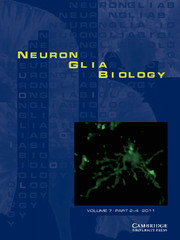Crossref Citations
This article has been cited by the following publications. This list is generated based on data provided by
Crossref.
Fields, R. Douglas
and
Burnstock, Geoffrey
2006.
Purinergic signalling in neuron–glia interactions.
Nature Reviews Neuroscience,
Vol. 7,
Issue. 6,
p.
423.
Christensen, Randolph N.
Ha, Byeong Keun
Sun, Fang
Bresnahan, Jacqueline C.
and
Beattie, Michael S.
2006.
Kainate induces rapid redistribution of the actin cytoskeleton in ameboid microglia.
Journal of Neuroscience Research,
Vol. 84,
Issue. 1,
p.
170.
Burnstock, Geoffrey
2007.
Physiology and Pathophysiology of Purinergic Neurotransmission.
Physiological Reviews,
Vol. 87,
Issue. 2,
p.
659.
Noda, Mami
Sasaki, Kenjiro
Ifuku, Masataka
and
Wada, Keiji
2007.
Multifunctional effects of bradykinin on glial cells in relation to potential anti-inflammatory effects.
Neurochemistry International,
Vol. 51,
Issue. 2-4,
p.
185.
Bennett, Max R.
Buljan, Vlado
Farnell, Les
and
Gibson, William G.
2008.
Purinergic junctional transmission and propagation of calcium waves in cultured spinal cord microglial networks.
Purinergic Signalling,
Vol. 4,
Issue. 1,
p.
47.
Zhao, Zhiqiang
Walczysko, Petr
and
Zhao, Min
2008.
Intracellular Ca2+ stores are essential for injury induced Ca2+ signaling and re‐endothelialization.
Journal of Cellular Physiology,
Vol. 214,
Issue. 3,
p.
595.
Beck, Andreas
Penner, Reinhold
and
Fleig, Andrea
2008.
Lipopolysaccharide‐induced down‐regulation of Ca2+release‐activated Ca2+currents (ICRAC) but not Ca2+‐activated TRPM4‐like currents (ICAN) in cultured mouse microglial cells.
The Journal of Physiology,
Vol. 586,
Issue. 2,
p.
427.
Seo, Dong Reoyl
Kim, Soo Yoon
Kim, Kyung You
Lee, Hwan Goo
Moon, Ju Hyun
Lee, Jae Souk
Lee, Se Hoon
Kim, Seung U.
and
Lee, Yong Beom
2008.
Cross talk between P2 purinergic receptors modulates extracellular ATP-mediated interleukin-10 production in rat microglial cells.
Experimental and Molecular Medicine,
Vol. 40,
Issue. 1,
p.
19.
Kobayashi, Kimiko
Yamanaka, Hiroki
Fukuoka, Tetsuo
Dai, Yi
Obata, Koichi
and
Noguchi, Koichi
2008.
P2Y12Receptor Upregulation in Activated Microglia Is a Gateway of p38 Signaling and Neuropathic Pain.
The Journal of Neuroscience,
Vol. 28,
Issue. 11,
p.
2892.
Mingam, Rozenn
Smedt, Véronique De
Amédée, Thierry
Bluthé, Rose-Marie
Kelley, Keith W.
Dantzer, Robert
and
Layé, Sophie
2008.
In vitro and in vivo evidence for a role of the P2X7 receptor in the release of IL-1β in the murine brain.
Brain, Behavior, and Immunity,
Vol. 22,
Issue. 2,
p.
234.
Fields, R. Douglas
2009.
Astrocytes in (Patho)Physiology of the Nervous System.
p.
443.
Jo, Daehyun
Chapman, C. Richard
and
Light, Alan R.
2009.
Glial Mechanisms of Neuropathic Pain and Emerging Interventions.
The Korean Journal of Pain,
Vol. 22,
Issue. 1,
p.
1.
McMahon, Stephen B.
and
Malcangio, Marzia
2009.
Current Challenges in Glia-Pain Biology.
Neuron,
Vol. 64,
Issue. 1,
p.
46.
Martín-Moreno, Ana María
Reigada, David
Ramírez, Belén G.
Mechoulam, R.
Innamorato, Nadia
Cuadrado, Antonio
and
de Ceballos, María L.
2011.
Cannabidiol and Other Cannabinoids Reduce Microglial Activation In Vitro and In Vivo: Relevance to Alzheimer's Disease.
Molecular Pharmacology,
Vol. 79,
Issue. 6,
p.
964.
Kettenmann, Helmut
Hanisch, Uwe-Karsten
Noda, Mami
and
Verkhratsky, Alexei
2011.
Physiology of Microglia.
Physiological Reviews,
Vol. 91,
Issue. 2,
p.
461.
Eichhoff, Gerhard
Brawek, Bianca
and
Garaschuk, Olga
2011.
Microglial calcium signal acts as a rapid sensor of single neuron damage in vivo.
Biochimica et Biophysica Acta (BBA) - Molecular Cell Research,
Vol. 1813,
Issue. 5,
p.
1014.
Kim, Beomsue
Jeong, Hey-kyeong
Kim, Jong-hyeon
Lee, Sang Yoon
Jou, Ilo
and
Joe, Eun-hye
2011.
Uridine 5′-Diphosphate Induces Chemokine Expression in Microglia and Astrocytes through Activation of the P2Y6 Receptor.
The Journal of Immunology,
Vol. 186,
Issue. 6,
p.
3701.
Hidetoshi, Tozaki‐Saitoh
Makoto, Tsuda
and
Inoue, Kazuhide
2012.
P2Y receptors in microglia and neuroinflammation.
Wiley Interdisciplinary Reviews: Membrane Transport and Signaling,
Vol. 1,
Issue. 4,
p.
493.
Kobayashi, Kimiko
Yamanaka, Hiroki
Yanamoto, Fujio
Okubo, Masamichi
and
Noguchi, Koichi
2012.
Multiple P2Y subtypes in spinal microglia are involved in neuropathic pain after peripheral nerve injury.
Glia,
Vol. 60,
Issue. 10,
p.
1529.
Burnstock, Geoffrey
and
Verkhratsky, Alexei
2012.
Purinergic Signalling and the Nervous System.
p.
433.




